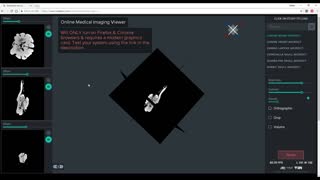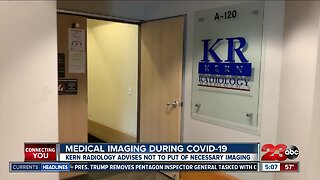Premium Only Content

Luciferase-Modified Magnetic Nanoparticles in Medical Imaging (Copy)
By Philip Renkert, Emily Chen, and Megan Mazzatenta
Bioluminescent animals such as fireflies and dinoflagellates produce natural light in order to find mates and to protect their species from predators, but that same light has potential to greatly improve current medical practices. Medical imaging is crucial for tracking the progress of disease throughout the human body, but the synthesized chemicals currently used in the process inflict additional harm on the body, leaving scientists searching for a less invasive imaging method. By processing magnetic nanoparticles that are coated in luciferase, the main enzyme involved in bioluminescence, cells can be individually tracked in a natural, non-toxic manner.
In animals, agitation from the environment creates a flow of protons that bring the enzyme luciferase in contact with the compound luciferin. The luciferin is then oxidized in the presence of other compounds, such as adenosine triphosphate, and photons are released to generate light. Luciferase can be applied to track and image the growth of diseases, like cancer, noninvasively. Current medical imaging often requires the use of radiology, but because these techniques involve large amounts of radiation, there is often damage to the body. The light produced from the luciferase reaction is what gives the magnetic nanoparticles the ability to expose abnormal cell growth patterns, eliminating the need for other light sources that could harm the cells. A sensitive charge-coupled device camera can then be used to create a clear picture of the growth patterns by detecting the position of emitted light over time.
In processing luciferase for potential medical use in animals and humans, superparamagnetic iron oxide magnetic nanoparticles must first be synthesized by precipitating magnetite from a solution of ferric and ferrous ions. A polymer layer is added to prevent the particles from aggregating, and then the luciferase shell is added. The resultant processed MNP has a core with cubic spinel structure and is 40-119 nanometers in diameter. The superparamagnetic property of the nanoparticles can allow for cell manipulation by an external magnetic field. The cells targeted by certain nanoparticles can then be neutralized to lose function or separated from healthy ones. The nanoscale of the particles also allows for the tracking and manipulation of each cell individually, which can be done in a natural, safe way using the luciferase-modified MNPs.
In this video, we will explore the applications and possible drawbacks of the use of luciferase-modified magnetic nanoparticles in the medical imaging field.
References:
1. Cancer Gene Therapy and Cell Therapy. American Society of of Gene & Cell Therapy. http://www.asgct.org/general-public/e...
2. Dikmen, Z. G. A New Diagnostic System in Cancer Research: Bioluminescent Imaging (BLI). TUBITAK, 35 (2005) 65-70. http://journals.tubitak.gov.tr/medica...
3. Gupta, A. K.; Gupta, M. Synthesis and surface engineering of iron oxide nanoparticles for biomedical applications. Biomaterials 2005, 26(18), 3995–4021 DOI: 10.1016/j.biomaterials.2004.10.012.
4. Kocher, B.; Piwnica-Worms, D. Illuminating Cancer Systems With Genetically-Engineered Mouse Models and Coupled Luciferase Reporters In Vivo. Cancer discovery 2013, 3(6) 616-629 DOI: 10.1158/2159-8290.CD-12-0503.
5. Meroni, G.; Rajabi, M.; Santaniello, E. D-Luciferin, derivatives and analogues: synthesis and in vitro/in vivo luciferase-catalyzed bioluminescent activity. ARKIVOC 2009, 265-288.
6. Okabe, Y. Quantum dots for in vivo imaging: Disadvantages of Quantum Dots. University of California, Irvine. http://bme240.eng.uci.edu/students/07...
7. Roura, S.; Gálvez-Montón, C.; Bayes-Genis, A. Bioluminescence imaging: a shining future for cardiac regeneration. Journal of Cellular and Molecular Medicine 2013, 17(6) 693-703 DOI: 10.1111/jcmm.12018.
8. Sadikot, R.T.; Blackwell, T.S. Bioluminescence Imaging. Proceedings of the American Thoracic Society 2005, 2(6) 537-540 DOI: 9.1513/pats.200507-067DS.
9. Vasquez, E. S.; Feugang, J. M.; Willard, S. T.; Ryan, P. L.; Keisha, W. B. Journal of Nanobiotechnology 2016, 14 (20), DOI: 11.1186/s12951-016-0168-y.
10. Xu, T.; Close, D.; Handagama W.; Marr E.; Sayler G.; Ripp S. The Expanding Toolbox of In Vivo Bioluminescent Imaging. Frontiers in Oncology 2016, 6(150) DOI: 10.3389/fonc.2016.00150.
11. Zborowski, M.; Chalmers, J. J.; Lowrie, W. G. Magnetic Cell Manipulation and Sorting. Microsystems and Nanosystems Microtechnology for Cell Manipulation and Sorting 2016, 15–55 DOI: 10.1007/978-3-319-44139-9_2.
Sources: Images, Video Clips, and Audio
https://docs.google.com/document/d/1I...
Link to the Original Video Upload: https://www.youtube.com/watch?v=SIIes052B4E
-
 7:14
7:14
IVALA® - 3D Veterinary Anatomy - Promo
4 years agoOnline Medical Imaging Viewer - 3D Veterinary Anatomy & Learning IVALA®
122 -
 7:14
7:14
IVALA® - 3D Veterinary Anatomy - Promo
4 years ago $0.05 earnedBETA - Online Medical Imaging Viewer - 3D Veterinary Anatomy & Learning IVALA
73 -
 2:04
2:04
KERO
5 years agoMedical imaging during COVID-19
881 -
 2:14
2:14
WFTX
3 years agok9 medical treatment
82 -
 1:21
1:21
Insights with Daniel
3 years agoUsing Imaging
10 -
 1:45
1:45
tafoyaB
3 years agoWooden Magnetic Knife Holder
92 -
 3:21:57
3:21:57
I_Came_With_Fire_Podcast
19 hours agoCHINA CENSORED AMERICANS | NO PRAYER DOWN UNDER | SAVE ACT
69.2K13 -
 1:26:01
1:26:01
Roseanne Barr
15 hours ago $23.92 earnedAbsolutely Fabulous W/ Shannon Hughey #94
98K26 -

SpartakusLIVE
13 hours agoDuos w/ Nicky || Friday Night HYPE
7.23K -
 2:06:42
2:06:42
TimcastIRL
11 hours agoPolice ARREST "MR SATAN" For Threatening To ASSASSINATE Trump, KILL ICE Agents | Timcast IRL
236K259